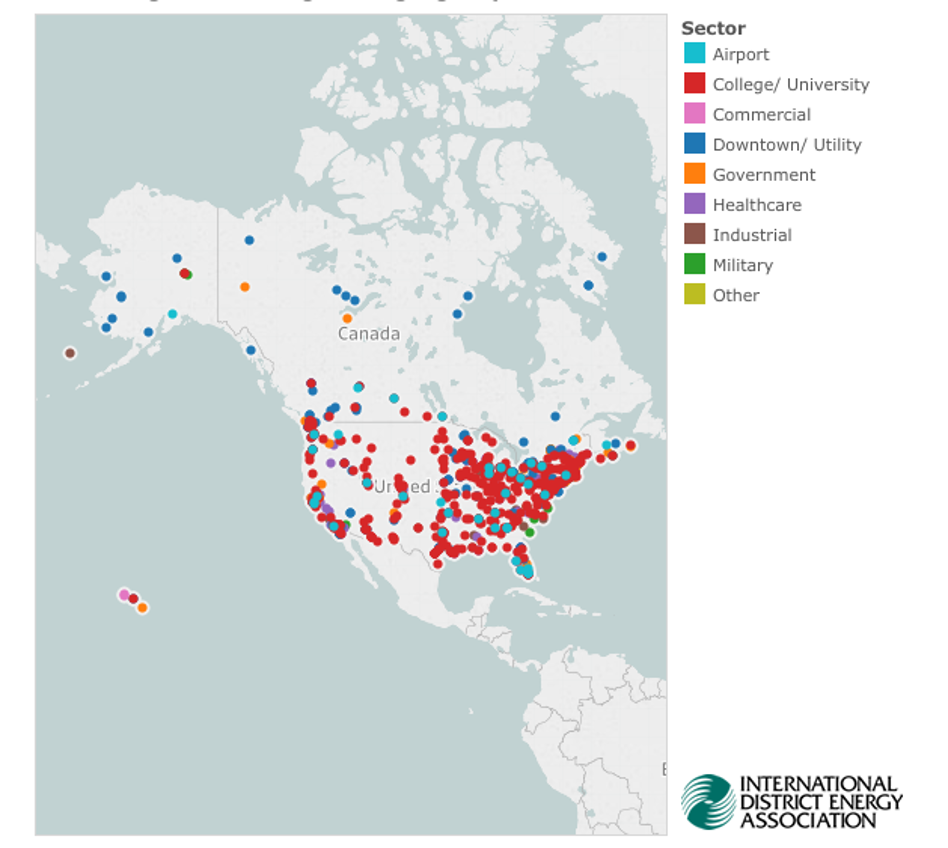The Halifax Regional Municipality (HRM) is redeveloping the existing Cogswell Interchange area located in downtown Halifax. As part of this redevelopment plan, HRM requested Halifax Water explore the feasibility of an Ambient Temperature District Energy System (ATDES) in the Cogswell area. The ATDES would be constructed in conjunction with the overall Cogswell redevelopment project.
District energy systems are networks of hot and cold water pipes, or ambient temperature water pipes, typically underground, that are used to deliver or remove thermal energy to efficiently heat and cool buildings. The waste and renewable energy contained in wastewater comes from commercial and residential hot water heating, other residential, commercial and industrial processes, wet weather run-off, and through geothermal exchange within the Halifax Water’s underground wastewater collection system. This waste stream can also be used for cooling.
The Cogswell ATDES would transfer thermal energy from the treated effluent at the nearby Halifax Wastewater Treatment Facility (WWTF) to the new buildings via a network of underground pipes. The ATDES would include an energy centre located at the Halifax WWTF that would provide heat exchange capacity between the wastewater effluent stream and the ATDES piping loop; supply (red) and return (blue) pipe loops; an energy transfer station to connect each building to the ATDES, and individual mechanical rooms located in each new building. The mechanical rooms would include heat exchangers, energy meters, and heat pumps to transfer energy between the ATDES piping loop and the building systems.
Wastewater effluent can provide a continuously renewable energy resource. This resource can be used to replace and/or offset the use of non-renewable, fossil fuel-based energy sources (e.g. oil, natural gas, electricity) for the purpose of heating and cooling and their corresponding GHG emissions. Other benefits include:
- flexible building design;
- lower energy costs;
- lower operating and maintenance costs;
- enhanced comfort providing cooling and heating in one convenient and cost-effective package;
- optimal energy efficiency;
- reduced GHG emissions;
- improved local air quality;
- energy resilience and security;
- energy price stability;
- and reliable, proven technology.
The Halifax WWTF effluent stream has ample capacity to provide the predicted peak heating and cooling needs for the buildings planned in the Cogswell redevelopment area.
District heating systems and refrigerant-based heat pump technology have both been around since the mid-1800s. Ground/water source heat pumps were initially developed in the late 1940s. Heat pumps are now used throughout the world as very energy-efficient heat transfer systems in residential, commercial and industrial applications, providing years of reliable, energy-efficient service with minimal operating costs and reduced GHG emissions compared to conventional fossil fuel-based technologies. The ATDES also has some similarities to geo-exchange systems, which are now being widely utilized around the world and which are known for their energy efficiency, low operating costs, and reliability.
Some ambient temperature and wastewater/sewage heat recovery district energy projects in Canadian jurisdictions:
Cheakamus Crossing ATDES, Whistler, BC (2010, AT WW Effluent)*
https://www.whistler.ca/services/water-and-wastewater/district-energy-system
http://www.cheakamuscrossing.ca/
Southeast False Creek DHS, Vancouver, BC (2010, Raw Sewage/NG)*
http://vancouver.ca/home-property-development/southeast-false-creek-neighbourhood-energy-utility.aspx
http://vancouver.ca/docs/planning/renewable-energy-neighbourhood-utility-factsheet.pdf https://www.youtube.com/watch?v=19OXEmaSs-8
Blatchford DESS, Edmonton, AB (In Development, Raw Sewage/Geo-Exchange)*
https://www.edmonton.ca/projects_plans/blatchford.aspx
https://www.edmonton.ca/city_government/initiatives_innovation/blatchford-district-energy-sharing-system.aspx https://www.youtube.com/watch?v=acjC8dVIHwM
Saanich ATDES, Victoria, BC (2011, WW Effluent)*
https://www.crd.bc.ca/project/past-capital-projects-and-initiatives/saanich-peninsula-water-transmission-main-heat-recovery
https://www.pembina.org/reports/ctax-casestudy-saanich.pdf
Markham District Energy, Markham, ON (2000 + 2012, NG CHP)*
http://www.markhamdistrictenergy.com/
https://www.markham.ca/
Alexandra DEU, Richmond, BC (2015, AT Geo-Exchange)*
https://www.richmond.ca/sustainability/energysrvs/DistEnatCity.htm?PageMode=HTML
University of British Columbia, Kelowna, BC (2011, AT Geo-Exchange)
http://facilities.ok.ubc.ca/geoexchange/des-operation.html
Many other Canadian, US, European and Asian Systems
* Examples of municipally mandated district energy systems
The proposed Cogswell ATDES will be owned, operated, and maintained by Halifax Water. As an existing and longstanding regulated utility, Halifax Water is in the unique position to provide the required capital infrastructure and necessary expertise to reliably operate and maintain the Cogswell ATDES as a regulated public utility.
On February 7, 2020, Halifax Water applied to its regulator, the Nova Scotia Utility and Review Board (NSUARB) for a ruling that an ATDES could be operated by Halifax Water as a regulated public utility under the Public Utilities Act. On May 19, 2020, the NSUARB granted approval. Halifax Water is currently working on the final design of the needed infrastructure as well as a detailed business case and project costing and will seek the next level of approvals from the Halifax Water Board and NSUARB sometime during 2021/22. The project timing will be dependent on when the municipality commences the Cogswell District Redevelopment and when Halifax Water Board and NSUARB approvals are received. Click here to learn more about the Cogswell District Redevelopment.
Halifax Water’s proposed Ambient Temperature District Energy System (ATDES) is an example of Halifax Water’s commitment to reducing our greenhouse gas emissions and adapting & mitigating the effects of climate change through innovation while working with HRM to meet its HalifACT 2050 objectives. For details on HalifACT 2050, click here.
The Government of Canada is investing more than $5.5 million in this project through the Green Infrastructure Stream of the Investing in Canada infrastructure plan. The Government of Nova Scotia is contributing more than $4.6 million, while the Halifax Regional Water Commission is contributing more than $3.7 million.
Learn more: https://halifaxwater.ca/news/cogswell-district-energy-system-funding-support



